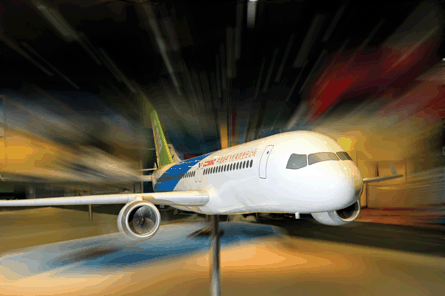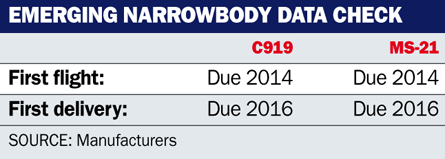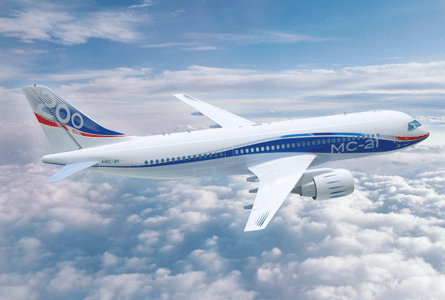Russia and China are each pursuing plans to beat Airbus and Boeing to the market with new narrowbody commercial jets.
With the Western airframers yet to commit to timeframes for refreshment of their narrowbody families, the Commercial Air Corporation of China (Comac) and Russia's United Aircraft (UAC) are aiming to bring new airliners to the market in 2016.
Specifications for the C919 narrowbody passenger jet in development by Comac were revealed during the Asian Aerospace exhibition in Hong Kong in September, where the manufacturer displayed a large-scale concept model.
Assistant general manager Wang Wenbin disclosed that there would be a standard model with a range of 4,075km (2,200nm) and a long-range model able to fly 5,555km. The C919 will seat 169 passengers in all-economy class or 156 in a mixed-class configuration.
 |
|---|
© BillyPix |
Comac is targeting a first flight in 2014 and to certificate and deliver the aircraft two years later. The Chinese firm is in negotiations with Western and local suppliers, including engine manufacturers.
Aviation Industry Corporation of China (AVIC) Commercial Engines wants to supply engines, but has conceded that the first C919s are likely to have Western powerplants, given the improbability of developing new engines by 2016. Accordingly, Comac is speaking to all the major Western engine-makers.
"We are interested in the C919 and have initiated discussions with Comac," confirms Pratt & Whitney. "We believe that the PW1000G offers a new airplane such as the C919 considerable market value."
 |
|---|
The PW1000G GTF geared turbofan engine, which will power Bombardier Aerospace's CSeries airliners, is due to be ready for service in 2013.
Speaking at the Asian Aerospace Congress, P&W's vice-president commercial engines for China, Thomas Nakano, had indicated the manufacturer's preference to provide an International Aero Engines powerplant to the C919 programme. However, Comac appears to favour the GTF option.
"Comac has expressed an interest in the PurePower engine for its proposed new aircraft," says P&W. "We see an excellent fit for the PW1000G's game-changing performance and environmental capabilities with the C919, and would be interested in pursuing it."
Safran and its partner GE Aviation are also seeking involvement in the C919 programme, and towards this goal have placed manufacturing work in China via Nexcelle, a joint-venture nacelle company formed by GE's Middle River Aircraft Systems and Safran company Aircelle.
 |
|---|
MAJOR SYSTEMS SELECTION
Comac says major systems for the C919, such as the engines and landing gear, will be selected towards the end of the year. Safran's Messier-Dowty and Messier-Bugatti, along with three AVIC companies, have submitted a joint proposal for landing gear and brake systems. In the engine competition, Safran-GE joint venture CFM is proposing the CFM Leap X engine.
According to Comac's director of marketing and sales Chen Jin, engine manufacturers have been told that the C919's engines must offer 12-15% lower fuel consumption than today's powerplants, The C919 will deploy advanced aerodynamics and make extensive use of "advanced materials to reduce weight". Comac is aiming is to secure a launch customer in the first half of 2010, says Chen.
Meanwhile, Russia's national airframer UAC is proceeding with plans to launch a three-member MS-21 twinjet family to replace the Tupolev Tu-204. The first model, the MS-21-200, will have 150 seats in a single-class configuration. The -300 and -400 will have 181 and 212 seats, respectively.
 |
|---|
© UAC |
For each model, basic and extended-range versions are planned. In each case the basic model will have a range of 3,500km. The extended-range versions of the -200 and -300 will each have a range of 5,000km while the extended-range -400 will fly 5,500km. A very-long-range MS-21-200LR has also been mooted.
A pre-design phase is under way, with working design to follow in 2010. A first prototype is due to be ready in 2013 and to fly in 2014. The aircraft will be built at Irkutsk.
Contractors were selected following international tenders invited last year by Irkut, which is part of UAC. In July 2007 Irkut was granted approval as the prime contractor for the MS-21. Pilot approval for the project followed a year later in August 2008. Financing is split 60% between the Russian state government and 40% from the manufacturer. A provision of Rb72 billion ($2.3 billion) has been made to fund the programme.
In addition to steering the project, Irkut will act as a system integrator. It expects the MS-21 to achieve Russian certification in 2015 and to gain European approval and enter service in 2016. UAC will develop computers for the MS-21, while work on the aircraft type's composite wing will be conducted by UAC daughter company Aerocomposite.
Among the firms chosen to supply "first-level" systems to the MS-21 programme is Hydromash, which is developing the landing gear. The auxiliary power units and wing de-icing systems will be supplied by Hamilton Sundstrand, which will also work in conjunction with NPO Nauka and Kidde Technologies' L'Hotelier unit to develop, respectively, air conditioning and fire protection systems.
Eaton Aerospace is supplying hydraulic controls, with 50% of component production to be carried out by Russian firms Voskhod, Teploobmennik, Tekhpribor and Znamya.
Cabin interiors are being developed by Zodiac's C&D business, while the same company's Intertechnique unit will supply fuel management and oxygen systems. Intertechnique is also developing a gas inerting system with Hamilton Sundstrand, which is working with another arm of Zodiac - its ECE subsidiary - on electrical systems.
Manufacturers competing to provide engines for the export version of the MS-21 are required by Irkut to enlist Russian partners. P&W, a finalist in the engine competition, says "it is too early to tell the exact distribution of work for this programme", but adds that Perm Motors is an "appealing potential base for work associated with the [MS-21] project", with P&W holding 25% of Perm and its affiliate Aviadvigatel. "However, we will not be able to make those types of decisions until after an engine provider is selected and terms are negotiated," cautions the company.
P&W is offering its PW1000G GTF. "The [MS-21] programme would enable Pratt & Whitney to extend its PW1000G models to the 30,000lb thrust class," says the manufacturer.
Rolls-Royce has also been shortlisted as a prospective engine supplier. Sources at Irkut say that R-R would link up with Moscow-based engine specialist Salyut. It has been suggested that Aviadvigatel's PS-14 could power domestic versions of the aircraft.
POWERPLANT SELECTION
At the MAKS air show in Moscow in August, Irkut president Oleg Demchenko said that a choice of engine manufacturer would be made by the end of 2009. "Selection of the powerplant is the most important of all the tenders we've invited," he added. "We need to scrutinise several technical issues before making it."
Rockwell Collins and Avionika are to bid for the avionics package, while Liebherr Aerospace and a consortium consisting of Aviapribor, Goodrich and Moog will compete to supply integrated controls. Irkut expects to complete selecting contractors to supply these three systems by 1 November.
 |
|---|
© Airbus |
The MS-21 "will have a composite structure", Alexey Fedorov, chairman and president of UAC, said in July. "For us it is a very big challenge, but that gives us a lot of advantage in the global market. We have a lot of negotiations with some companies in Europe and there should be an agreement by the end of the year. Just the design and development part of that will be with Western partners." Likely candidate partners include composite aerostructures specialists such as Aerolia, GKN and Spirit AeroSystems. The relationships are intended to be risk-sharing.
At the Paris air show, Demchenko revealed that feedback on the MS-21 proposals had been solicited from 42 potential operators, but admitted that it was difficult to accelerate the discussions without a finalised configuration including aircraft and engines.
Nevertheless, UAC has projected a production run of 1,200 MS-21 aircraft within 25 years. Only 300 of these are intended for the domestic market. "It is a product for the global market," says Fedorov.
Source: Flight International























